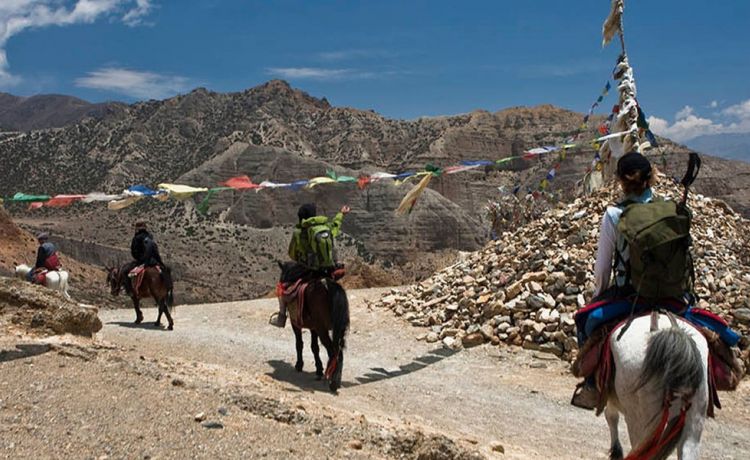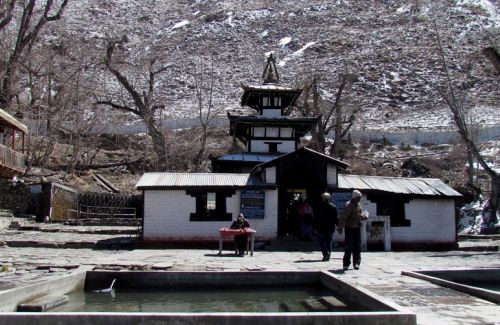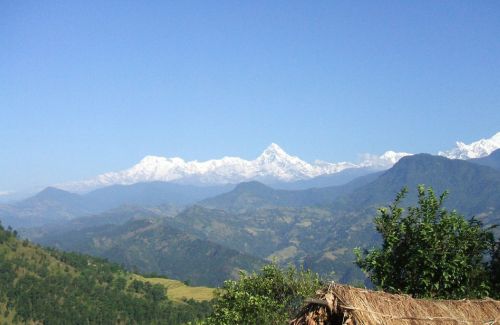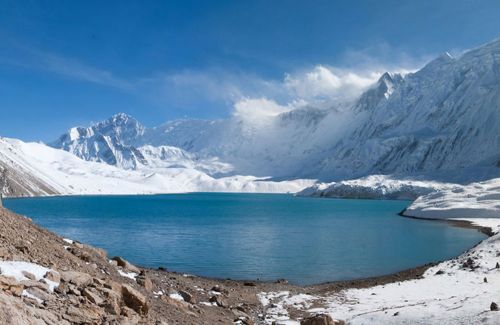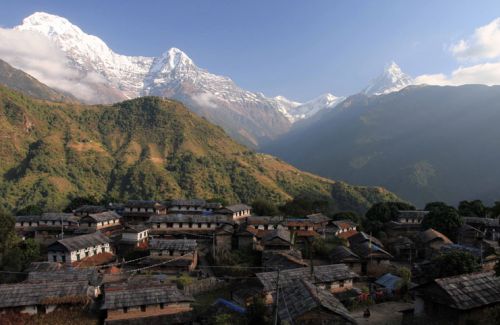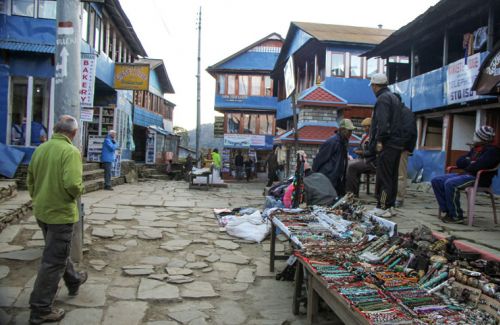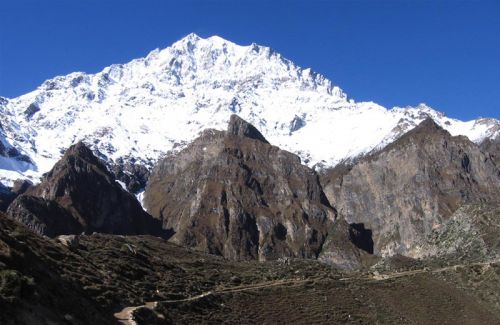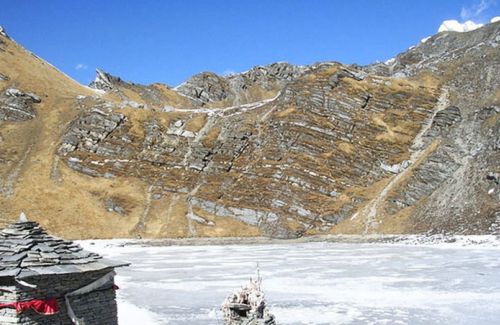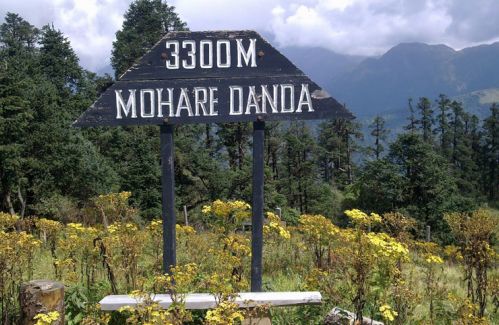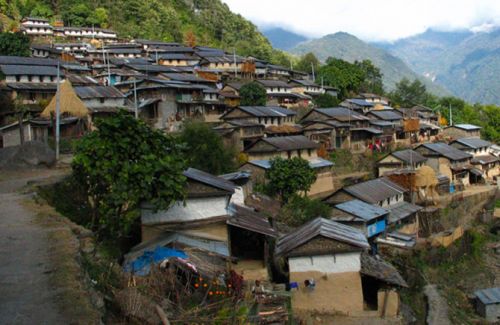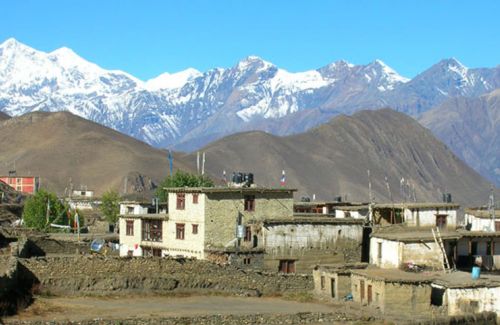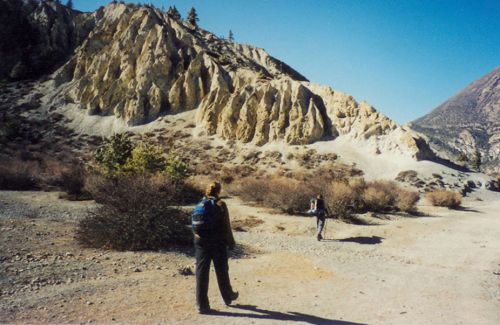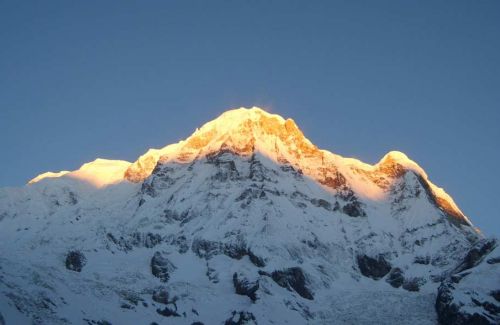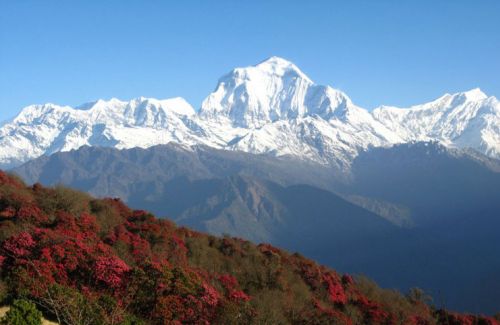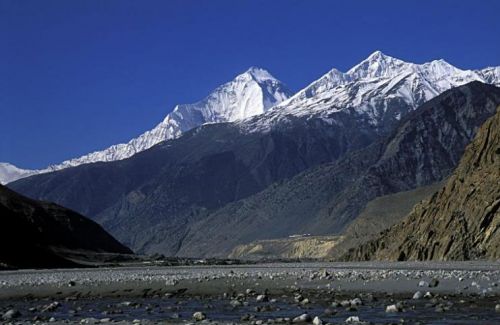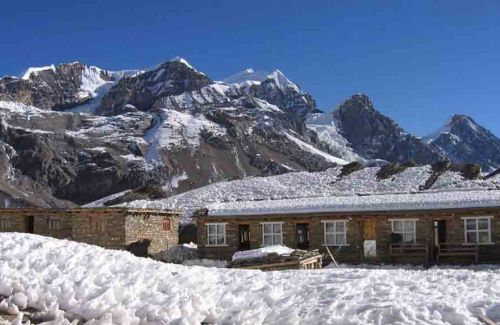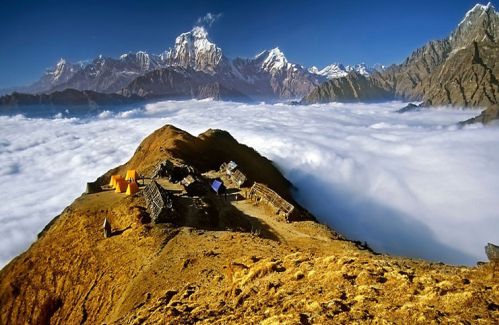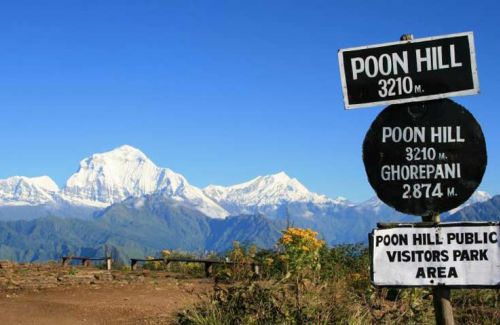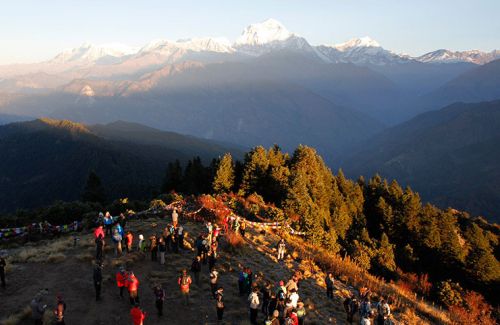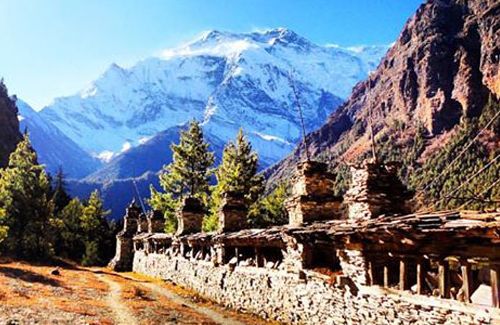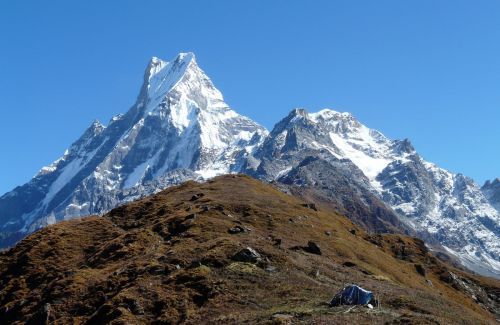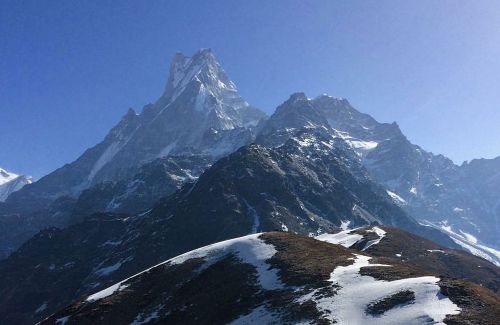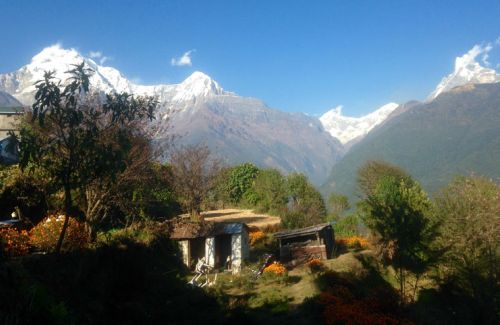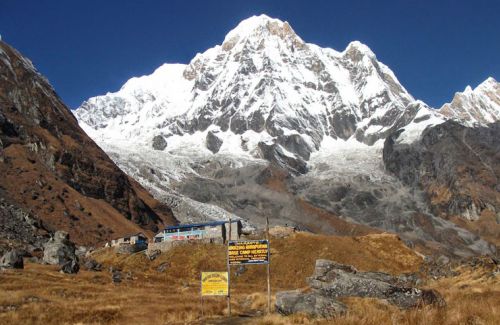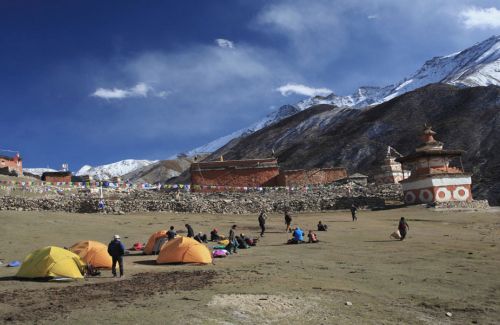Mustang Trekking
- Duration17 Days
- Max. Altitude3780 m
Destination:Nepal
Trip Grade:Moderate (**)
Meals:Breakfast + Lunch + Dinner
Transportation:Private Vehicle / Aeroplane
Accommodation:Lodge
Trekking Region:Upper Mustang
Show AllMustang Trekking as a holiday destination
The most popular of the restricted-area treks, the Upper Mustang trail follows the traditional salt trade route to Tibet from the Mustang lowlands. It leads to the former Tibetan kingdom of Lo; a remote, arid land bordering Tibet graced with spectacular Tibetan monasteries, as well as numerous canyons and caves. Foreigners were only allowed into the region in 1991, and today Mustang is still known as the ‘Last Forbidden Kingdom’.
The best seasons for this trek are spring (March to May) and autumn (September to December). These boast the most clear and sunny days which provide the best views of the Himalayas, although the weather in the mountains is impossible to predict exactly.
Ethnicity/cultural experience
Centuries of isolation have kept the culture, lifestyle and heritage of the Loba (Mustangis) largely unchanged. The venerated leader of the community still holds the title of ‘king’, while many Mustangi families maintain the unique familial practise of polyandry, in which all the brothers in the family share a single wife. The trail also passes through the walled town of Lo-Manthang, which features some of the most stunning medieval architecture in the region. Another cultural highlight is the Tiji festival, celebrated at the end of the dry season in late winter.
The trail also goes past the temple at Muktinath; a pilgrimage site for both Hindus and Buddhists (and a great place for meditation), it is the site of one of the most ancient temples to the Hindu God Vishnu. Water from the ice-cold Kali Gantaki river flows through 108 stone faucets, and pilgrims (and a few hardy trekkers) stand under each of them. The founder of Tibetan Buddhism, Guru Rimpoche, is also believed to have meditated here on his way to Tibet. Both Hindus and Buddhists visit Mebar Lla Gomva, the small monastery of ‘miraculous fire’ (a continuously burning natural gas fire) located near the main entrance.
Getting there/coming back
Access is available by flight (Rs 9200) or by bus or jeep from Pokhara to Jomsom (Rs700-1000). There is also a direct bus route from Kathmandu to Jomsom (Rs 1800) that leaves at 14:30, arriving at 8:00am the following morning.
Trekking in the restricted area
This route is off the beaten-path, away from the ‘teahouse treks’ walked by the vast majority of trekkers to Nepal. These relatively untouched areas are called ‘restricted’ due to the limited number of visitors permitted to enter every year. Please check with us for availability. Unlike the more popular treks, the practise of catering to trekkers is not as ‘developed’, although there are basic lodges and teahouses available on the route. This trek requires an additional permit fee that can only be arranged via a trekking agency (we can provide this). The initial permit is valid for 10 days, with each additional day costing extra after that.
Scenic beauty
Beginning form the world’s deepest gorge in Kaligandaki, the trail leads on to the world’s highest region of Lo-Mangthang Valley, with a landscape akin to that of the Tibetan highlands boasting excellent panoramic views of Nilgiri, Annapurna, Dhaulagiri and several other peaks along the way. The trail also passes through the scenic mountain pass at Taklam La, glaciers and alpine valleys.
Difficulty level
This trek is at moderate difficulty, it is recommended that you have some prior trekking experience, but this is not essential. Every trek in the Himalayas requires a certain level of physical and mental fitness. You should be in good physical shape and feel comfortable hiking up and down 7-12 miles per day whilst carrying about 10 pounds. It is recommended that you carry out at least one hour of aerobic activity 3-4 times per week for at least 1 month before starting the trek. Aerobic conditioning is important, as it enables your body to better metabolize oxygen and prepare for thinner air (there is 40% less Oxygen than at sea level). If you are in any doubt of your physical readiness, please consult with a doctor beforehand. Always remember that stamina, confidence and continuity are more important than speed.
Further afield
Staying for longer than 10 days in the restricted area becomes increasingly expensive, but there are plenty of opportunities for trekkers to explore nearby non-restricted routes such as the Annapurna base camp, Poonhill or Jomsom-Muktinath trails.
Packing List for Mustang Trekking
If you are planning to venture on the ABC trek, these are the things you ought to carry with yourself:
- ravel documents: passport, visa, travel insurance, air tickets, voucher, passport sized photos
- Binoculars, alarm clock and torch/flashlight/headlamps, ear plug and eye mask,
- Reading and writing materials, travel games like , chess, backgammon, scrabble,
- Hand sanitizer, lip balm, face and body moisturizer, light weight towel, toiletries like toothbrush, toothpaste, multipurpose soap, deodorant, nail clippers, sanitary pads
- Money-cash and money bag,
- Sleeping bag
- Day pack (with waist straps), refillable water bottle
- Sun hat, sunglasses, scarf
- Bag liner,
- Sewing kit, swiss army knife, lighter, a small padlock
- Wind and waterproof shell jacket and trousers
- Comfortable walking shoes, running shoes and sandals
- Socks: thick wool blend and thin cotton to be worn in combination
- Lightweight thermal gloves
- T-shirts
- Underwear and shorts
- Long sleeved shirt
- Trekking/Hiking boots with spare laces
- Lightweight long trousers
- First Aid Kit
- Regular medicines
If travelling during winter:
- Layered clothing/thermals
- 1 heavyweight or 2 light weight wool jumper/sweater/fleece jacket
- Fleece wind-stopper jacket
- Down jacket or down vest
- Fleece or wool trousers
- Heavyweight gloves or mittens
- A four season sleeping bag
- Thick, warm wool hiking socks
-
Optional Gaiters
Trip Highlights
- Free Walking Tour in Kathmandu organized by Himkala Adventure
- Scenic drive from Kathmandu to Pokhara
- Unique landscape, dry land which is called Mini-Tibet of Nepal
Day to Day Itinerary
Day 01:Arrival in Kathmandu (1,350 m), transfer to hotel . O/N at Hotel
Day 02:After breakfast, Free Walking Tour Kathmandu, trek preparation. O/N at Hotel
Day 03:Drive from Kathmandu to Pokhara (827 m), 6-7 hrs. O/N at Hotel
Day 04:Fly to Jomsom from Pokhara and trek to Kagbeni, 4-5 hrs. O/N at Lodge
Day 05:Trek from Kagbeni to Chele (3050 m),5-6 hrs
Day 06:Trek from Chele to Zhaite (3730 m), 7-8 hrs
Day 07:Trek from Zhaite to Charang (3575 m) (via Dhakmnar and Lo Gekar), 5-6 hrs
Day 08:Trek from Charang to Lo Manthang (3820 m) (explore the ancient city), 5-6 hrs
Day 09:Lo-Manthang (Namgyal Gompa and Thinggar Valley) (3780 m), Rest Day
Day 10:Lo Manthang rest day and Explore around (3780 m), Rest Day
Day 11:Trek from Lo-Manthang to Dhakmar (3730 m) via Lo Gekar, 6-7 hrs
Day 12:Trek from Dhakmar to Geling (3570 m), 7-8 hrs
Day 13:Trek from Geling to Chuksang (2950 m), 5-6 hrs
Day 14:Trek from Chuskang to Jomsom (2750 m), 5-6 hrs
Day 15:Drive or fly back from Jomsom to Pokhara (827 m), 25 min. flight
Day 16:Drive from Pokhara to Kathmandu, 200 km, 6-7 hrs
Day 17:Departure to airport
Cost Include
- Airport Picks up and Drops off by private tourist vehicle
- 3 nights in Kathmandu and 2 nights in Pokhara, twin sharing basis accommodation of 2-3 star hotel with Breakfast
- Guided City Tour with private tourist vehicle
- A government licensed holder city tour guide
- Full Board Meal (Breakfast + Lunch + Dinner) during the trek
- Lodges, Guest Houses basis accommodation during the trek
- Drive from Kathmandu - Pokhara - Kathmandu with tourist coach
- Flight from Pokhara - Jomsom - Pokhara including airport departure taxes
- An experienced English speaking Trekking Guide
- The required number of local staff and porter (2 Trekkers = 1 porter)
- Food, accommodation, salary, insurance, equipment and medical kit for all staffs
- Annapurna Conservation Area Permit, TIMS, and Special Permit for Upper Mustang Trekking
- Down Jacket, Duffel Bag, and Sleeping Bag by Himkala Adventure if required
- Farewell Dinner in Nepalese Restaurant with Cultural show
- Government Taxes, VAT, and Service Charge
Cost Exclude
- Lunch and Dinner in Kathamndu and Pokhara
- Entrance Fees in Heritage Sites and other places
- Nepal Visa fee (bring accurate USD cash and two passport photographs)
- International airfare to and from Kathmandu
- Excess baggage charges
- Extra night accommodation/s in Kathmandu (if there will be due to some reason)
- Your Travel Insurance and rescue evacuation
- Personal expenses (phone calls, laundry, bar bills, battery recharge, extra porters, bottle or boiled water, shower etc)
- Personal Trekking Equipment
- Tips for guides and porters (Tipping is expected)
- Any costs that is not mentioned in Cost Includes Section
Trip Info
- Altitude Sickness
- Communications and Updates
- Conservation
- Cross Cultural Issues
- Essential Do’s and Don’ts
- Foot Ware/Foot Care
- Health and Fitness
- Himkala Crews
- Hypothermia
- Safety and Security
- Travel Insurance and Evacuation
- Trip FAQs
- Washing and Shower
- Water/Food and Nutrition
- Weather
- Trip Grading
- Accommodation/Shelter
- Equipment List
